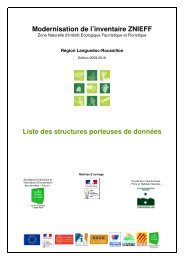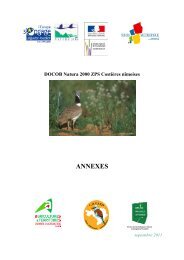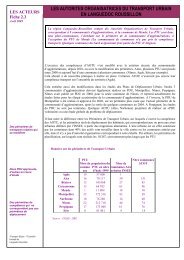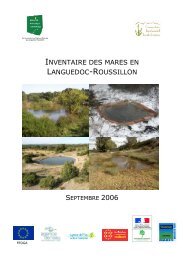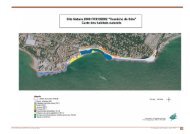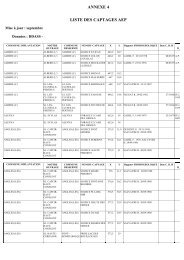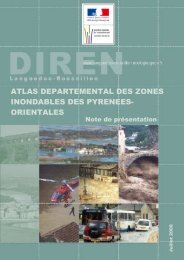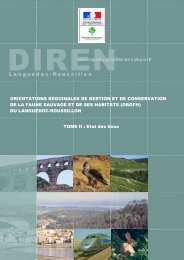Rapport de stage - DREAL Languedoc-Roussillon
Rapport de stage - DREAL Languedoc-Roussillon
Rapport de stage - DREAL Languedoc-Roussillon
Create successful ePaper yourself
Turn your PDF publications into a flip-book with our unique Google optimized e-Paper software.
Mémoire <strong>de</strong> Travail <strong>de</strong> Fin d’Etu<strong>de</strong> ENGEES – UDS – <strong>DREAL</strong> LR<br />
Abstract<br />
Dystrophic processes measurement network construction study for<br />
evaluation in the <strong>Languedoc</strong>-<strong>Roussillon</strong> rivers<br />
Eutrophication is a natural phenomenon characterized by a vegetal proliferation due to<br />
high nutrients levels. Human activities can speed up the phenomenon or make it worse. In this<br />
way, eutrophication becomes a dystrophic process: it leads to a river imbalance and be the<br />
reason of the <strong>de</strong>ath of aquatic populations.<br />
In 1991, two European directives have been enacted in or<strong>de</strong>r to protect the environment.<br />
They impose restrictions more severe in areas where there is an eutrophication potential as<br />
sensitive areas (Urban Waste Water Directive) and vulnerable areas (Nitrates Directive). The<br />
application of these two directives needs the <strong>de</strong>finition of the areas where there is a risk or a<br />
presence of the eutrophication phenomenon to limit the most severe restrictions to theses areas.<br />
The <strong>de</strong>finition of these areas must be realised/reviewed every 4 years by the State<br />
Administration Services (<strong>DREAL</strong>)<br />
Currently, classification measurement networks are those created to respond to the<br />
Water Framework Directive (WFD), called monitoring networks. The problem is that the<br />
structure of these networks, adapted to the WFD <strong>de</strong>mands, is not compatible with<br />
eutrophication phenomenon diagnostic. We studied the available data and conclu<strong>de</strong>d that, even<br />
if a lot of biological or physical and chemical parameters are measured, no eutrophication<br />
information can be produced. The only biological compartment that produces relevant<br />
information is the macrophytes one but there is still an uncertainty on the reliability of the data<br />
when no other parameter is measured. The conclusion is we have to review the current<br />
networks in or<strong>de</strong>r to produce indisputable cartographic data.<br />
6/102<br />
The following study led to two ways of improvement:<br />
- Current networks data can be studied more precisely. It’s especially true for<br />
diatoms.<br />
- Measurement of oxygen dial variations is necessary, as some practical <strong>de</strong>tails<br />
measurement changes: networks screenplays are presented with their financial<br />
valuation.



